- When Are Raspberries Ready to Pick: A Comprehensive Guide for Gardeners - July 11, 2024
- When Are Red Delicious Apples Ready to Pick: Essential Harvesting Tips - July 11, 2024
- When Are Snow Peas Ready to Pick: Essential Harvest Tips - July 11, 2024
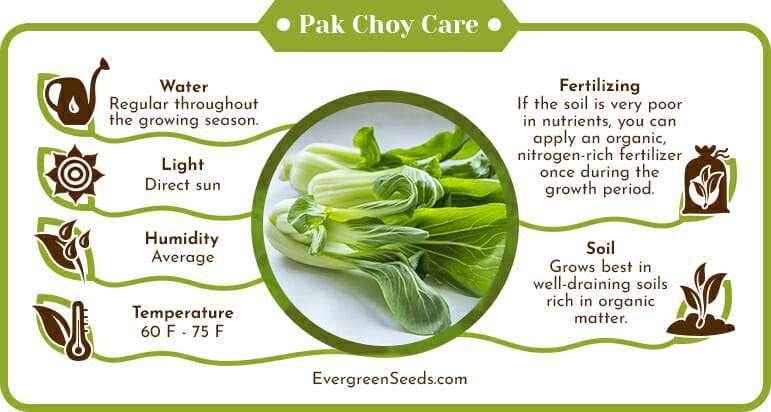 Pak choy, also known as pok choi or bok choy, is a type of non-heading cabbage belonging to the Brassicaceae family, cultivated for its tender stalks and flavorful leaves.
Pak choy, also known as pok choi or bok choy, is a type of non-heading cabbage belonging to the Brassicaceae family, cultivated for its tender stalks and flavorful leaves.
It’s among the more common Asian Brassica genus vegetables that you’ll find in stores, but it’s always best enjoyed fresh.
Fortunately, with this pak choy growing guide, it’s never been easier to grow your own at home.
Let’s find out how.
JUMP TO TOPIC
What is pak choy?
Named Brassica rapa chinensis in Latin, pak choy is a species of Chinese cabbage closely related to Napa cabbage and other Asian vegetables such as gai lan and choy sum, and their Western cousins: broccoli, kale, cauliflower, and cabbage.
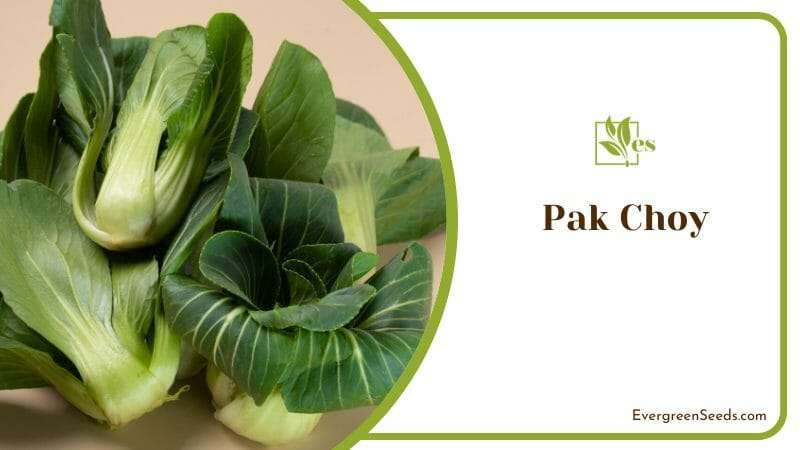 Depending on the variety, pak choy can grow anywhere between 5 inches and 1 foot tall (13 to 30 cm). Some varieties are harvested when they’re only 3 inches (8 cm) tall, commonly sold as baby bok choy.
Depending on the variety, pak choy can grow anywhere between 5 inches and 1 foot tall (13 to 30 cm). Some varieties are harvested when they’re only 3 inches (8 cm) tall, commonly sold as baby bok choy.
The plant also produces yellow flowers, which are similar in appearance to those of the rapeseed plant. All parts of pak choy are edible, but young stalks and leaves are the most prized parts.
Pak choy has been cultivated in China for centuries, and nowadays, it is one of the most widely used and instantly recognizable vegetables in Asian cooking.
It is tasty, nutritious, versatile, and easy to grow, making it a fantastic Asian vegetable for beginners and expert gardeners.
Bok choy varieties
There are two main types of pak choy you will find available on the market:
- White stemmed bok choy
- Green stemmed ‘Shanghai’ bok choy
The white stemmed variety can be considered the ‘classic’ white bok choy – after all, this vegetable’s name translates to ‘white cabbage.’ It produces long, thick, fleshy stalks that can be either white or cream-colored, with dark green, slightly crinkled leaves. The Shanghai variety is more compact, with rounder leaves and light green stalks.
On top of these two main pak choy varieties, you will also find hybrids suitable for cold or hot weather, with different colored leaves, and dwarf varieties known as baby bok choy. Depending on where you live, pick the right bok-choy seeds for your climate, and you can enjoy a bountiful harvest pretty much all year.
How to grow pak choy
Pak choy is one of the most popular Asian vegetables, and you will undoubtedly find it in many supermarkets.
However, it is effortless to grow and takes little time before it’s ready to harvest, which is why we recommend growing your own.
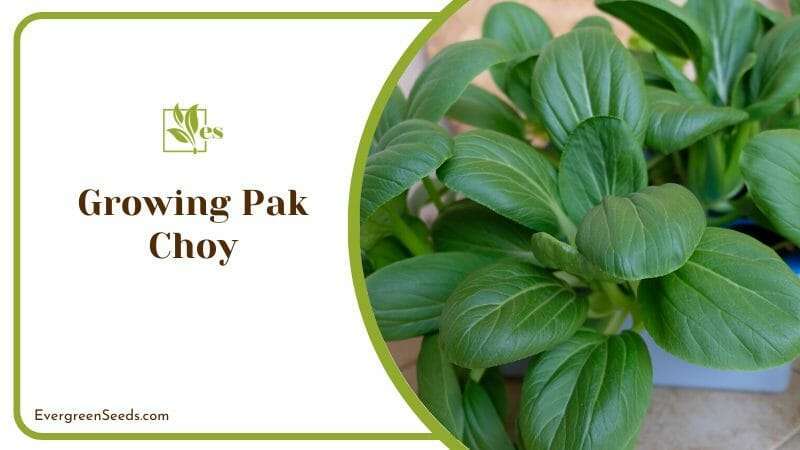
Here’s what you’ll need to get started.
1. When to plant pak choy
Like its cousins, gai lan and choy sum, pak choy is typically a cold season crop. We recommend growing it in either early spring or early autumn. Given the fact that it’s a fast-growing vegetable, you can even enjoy two crops of pak choy per year.
It can be sown outdoors when temperatures consistently stay above 50 °F (10 °C). Pak choy can tolerate a light frost, yet it’s best to avoid growing it in frigid temperatures, as this will cause the plants to bolt.
2. Germinating pak choy
To kickstart your pak choy growing season, you can sow the seeds indoors in compostable seedling trays. Plant one or two seeds per pot in a potting soil mix and cover it with a thin layer of soil. Use a spray pump to mist the seedlings, and keep them well watered in a warm and sunny part of your home.
Of course, if you live somewhere with mild early springs, you can sow your bok choy seeds in the garden soil directly – see the next section for the ideal conditions. Pak choy seeds are tiny and also very easy to germinate. Soaking them before sowing isn’t necessary, but it can reduce the germination time significantly.
On average, pak choy seeds can take around a week to sprout. But if you soak them in water for a few hours, you can see little seedlings emerge as early as 2 days after sowing.
3. Growing pak choy outdoors
Once each seedling has 2 sets of leaves, your pak choy is ready to be transplanted outdoors.
Here’s what you need to know.
 Soil
Soil
Start by preparing the soil bed for your pak choy. This vegetable grows best in well-draining types of soils rich in organic matter, so make sure to incorporate compost or manure in the substrate. The ideal soil pH should be between 6.0 and 7.0, although pak choy also tolerates a pH of up to 7.5.
 Location and temperature
Location and temperature
Pick a part of your garden that receives partial shade. As a cold-season crop, pak choy can tolerate full sun, but it usually only needs about 4 or 5 hours of direct sun per day.
The ideal temperature range for growing pak choy outdoors is between 60 °F and 75 °F (16 °C to 24 °C). Don’t worry if you experience a drop in temperature after your plants are established. A decrease in temperature to around 60 °F (16 °C) can give the stems a very juicy texture and increased sweetness, making autumn a perfect season for growing bok choy.
 Spacing and watering
Spacing and watering
Sow your pak choy seeds or transplant your seedlings 6 inches (15 cm) apart, and water well. This vegetable needs regular watering throughout the growing season, as drought will cause the plant to bolt and start producing seed.
Luckily, pak choy doesn’t require additional fertilizers, especially if you’ve planted it in soil that is rich in compost. However, if your garden soil is very poor in nutrients, you can apply an organic, nitrogen-rich fertilizer once during the growth period.
– Maintenance
Pak choy is a very sturdy crop for pests and diseases and doesn’t have many of the problems other members of the cabbage family encounter. Now and then, it can suffer attacks from slugs or cabbage worms, which enjoy eating the leaves.
Our tip is to manually remove these pests and discard them in a bucket of soapy water. Using chemical insecticides is not something we recommend.
4. How to harvest pak choy
Pak choy can be harvested at any point once it has at least 3 sets of leaves per plant. You can either pick it and serve as baby pak choy or allow it to spend more time in the soil. This will allow the stems to become thicker and meatier while also producing larger leaves.
To harvest pak choy, use a sharp knife and cut the plant at soil level. Pak choy is harvested and used whole, which is why we don’t recommend trimming just some of the leaves off the plant. Younger vegetables are sweeter and more tender, while pak choy allowed to grow up to 1 foot (30 cm) tall will have a crunchy, meatier texture, with a mild bitterness.
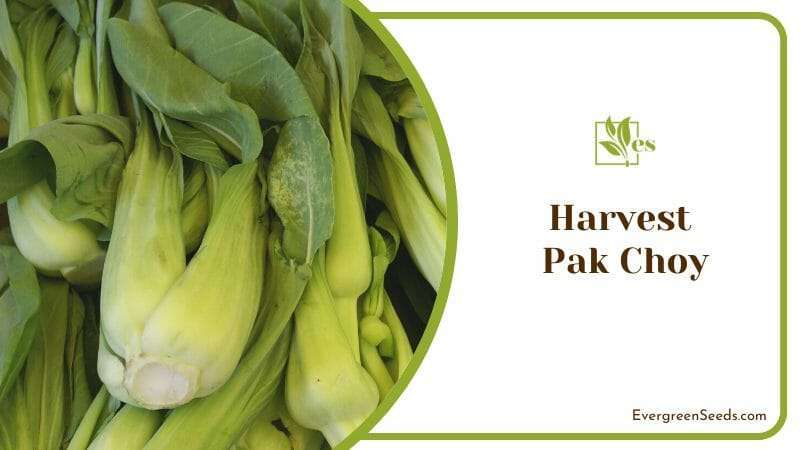
– Pak choy flowers
If you keep pak choy in the garden long enough, you will notice that it starts to bloom. The yellow flowers are very similar to those of the rapeseed plant and even gai lan. They are edible and are harvested along with their stalks, making an excellent addition to stir-fries and salads. Once pak choy starts flowering, the leaves are still juicy but noticeably more bitter, and the stems become a bit fibrous and tough.
– Storing fresh pak choy
After harvesting, you can keep your pak choy in the vegetable drawer of your fridge for up to a week. Store it in either plastic wrap or paper towels. Pak choy is always best when eaten fresh. If you notice that the leaves are starting to wilt and become yellow or that the stems are developing spots, that’s a sign that your pak choy has turned bad and should be discarded.
5. Can you regrow pak choy from cuttings?
Yes! Pak choy can quickly grow back after it’s been cut. Whether you harvest it from the garden or use pak choy from the store, you can use it to grow a new set of leaves and stalks.
For pak choy harvested from the garden, leave a small stump in the ground, about 1 inch (2.5 cm) tall. Continue watering it, and you will start seeing new growth after a few days.
For store-bought pak choy, trim the stalks and leaves and keep the stalk. Put the stalk in a shallow bowl half-filled with water, and poke some toothpicks on the sides to keep the bottom of the stalk from being submerged in water. Keep in a warm, sunny spot, and it will start growing roots and small leaves in less than a week.
After two weeks, you can transplant it to your garden or in a container with potting mix until it grows big enough to harvest again.
Uses for pak choy and baby bok choy
Pak choy is tasty, nutritious, and versatile, making it one of the easiest Asian vegetables you can cook with. It has a unique taste, with a mild sweetness, green notes, a hint of pepper and mustard bite, and a flavor that’s reminiscent of cabbage.
1. Health benefits of pak choy
Pak choy is also an excellent source of antioxidants, vitamins A, B6, C, K and E, and minerals such as magnesium, iron, potassium and calcium. It is low in carbohydrates and rich in fiber and is an excellent addition to any healthy diet.
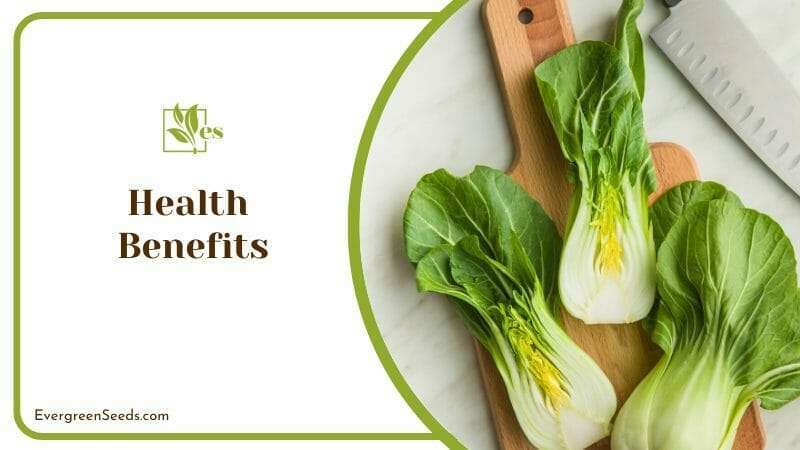
2. Cooking with pak choy
The thick, juicy stems of pak choy retain their texture very well, making them perfect for cooking or even eating them raw. You can enjoy pak choy in a wide variety of dishes, whether it’s stir-fried, sautéed, steamed, boiled, or grilled.
We recommend pairing it with aromatics such as ginger, garlic, chillies, hoisin or soy sauce, and sesame oil in either vegetarian or meat-based dishes for an authentic flavour profile.
3. Pak choy substitutes
If you can’t get your hands on pak choy, substitute it with other Asian leafy vegetables such as tatsoi, gai lan, yu choy, and even Napa cabbage. You can also use Western varieties from the same family in a pinch, such as chard, celery sticks, or mustard greens, although the taste won’t quite be the same.
Luckily, pak choy is very easy to grow, and with this growing and care guide, you can always have a steady supply fresh from your garden!












